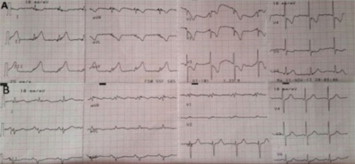Case report
A non-steroidal antiinflammatory drug diclofenac sodium was initiated by orthopedics clinic to 51 year-old male patient for his knee pain. After 45 minutes of ingestion of 100 mg diclofenac sodium lacrimation in his eyes, widespread pruritus in his body and severe chest pain had started and he was presented to our emergency department. On admission physical examination was normal except widespread erythematous rashes. His vital signs were stable. In his medical history there was not a history of any allergic disease and except being an ex-smoker he was devoid of any cardiovascular risk factor. Because of chest pain an ECG was performed and it revealed 2-3 mm ST segment elevation in DII-DIII and aVF leads and reciprocal changes in other leads (Figure 1.A). Because of presence of systemic allergic reaction pheniramine (antihistaminic) and dexamethasone (corticosteroid) treatments were initiated. Beside this because of the suspect of acute coronary syndrome enoxaparine and acetylsalicylic acid were administered. After initial treatment symptoms of patient was regressed and chest pain was resolved. Repeated ECG showed completely normal findings (Figure 1.B). The cardiac enzyme panel was within normal limits [troponin I (<0.005 ng/ml), CK-MB (2.25 ng/ml) and CK (131.8 u/l)]. The echocardiography was within normal limits and the coronary angiogram showed normal coronary arteries without any obstruction. In this patient, according to the development of allergic and cardiac symptoms after drug administration, dramatic respsonse to antihistaminic and corticosteroid treatment and according to the absence of coronary artery stenosis we thought that diclofenac was the triggering factor of an allergic reaction for development of this clinical picture. In 1991 Kounis and Zavras described the syndrome of allergic angina and allergic myocardial infarction, currently known as Kounis syndrome. This allergic reaction is known to be caused by inflammatory mediators such as histamine, chemokines and cytokines. Three variants of Kounis syndrome have been described previously: Type I variant includes normal coronary arteries without any risk factor for coronary artery disease. Type II variant includes patients with coronary artery disease and in type III, drug eluting stent thrombosis is the main pathologic condition.
There are several causes underlying this syndrome including some drugs, latex, foods, as well as various conditions and environmental exposures. Nonsteroidal anti-inflammatory drugs are frequently used in daily clinical practice and they are the second most commonly seen class of medications causing anaphylaxis. Because NSAIDs are among the most widely used drugs, their possible side effects should be known by all physicians. The systemic anaphylactic reaction caused by inflammatory mediators released during the activation process should be controlled early in the management of these patients. In our case we established a rapid diagnosis and the appropriate antiallergic treatment was started accordingly. The result was excellent with the full recovery of our patient.





